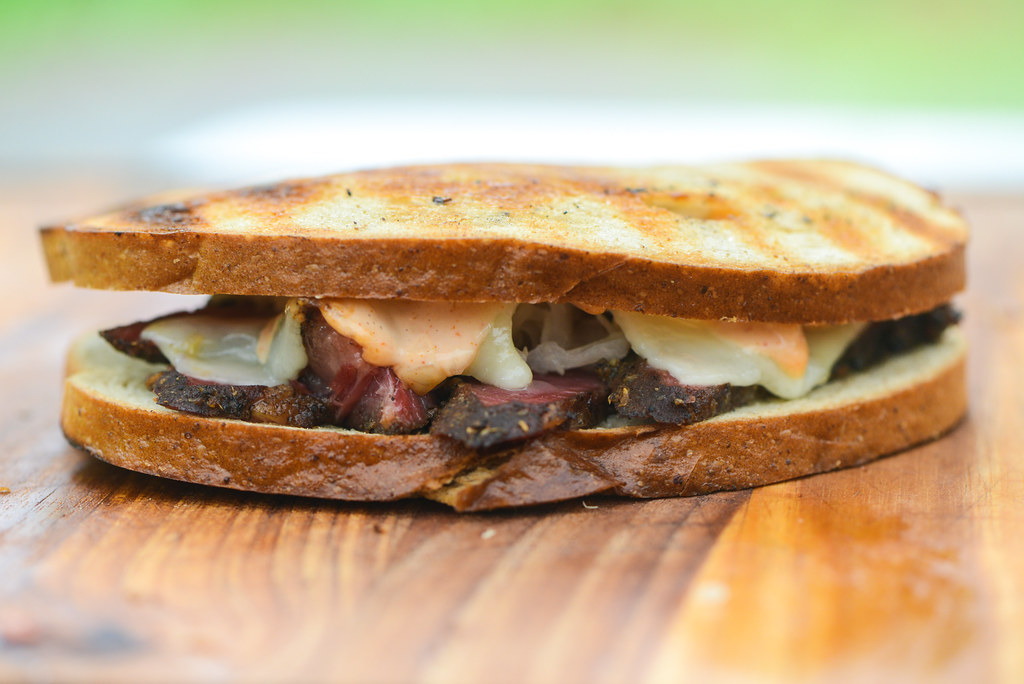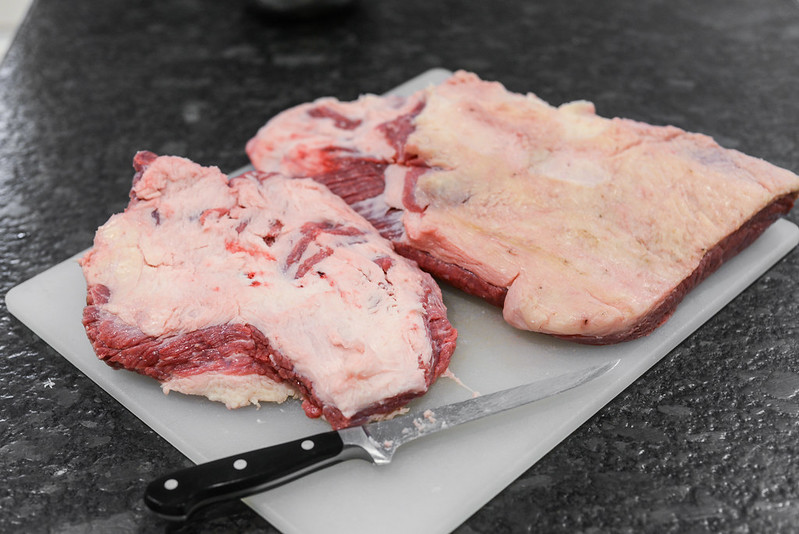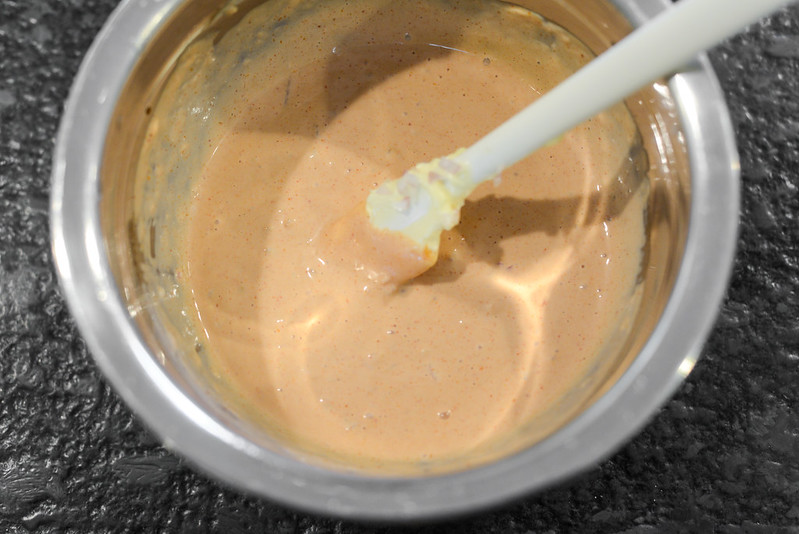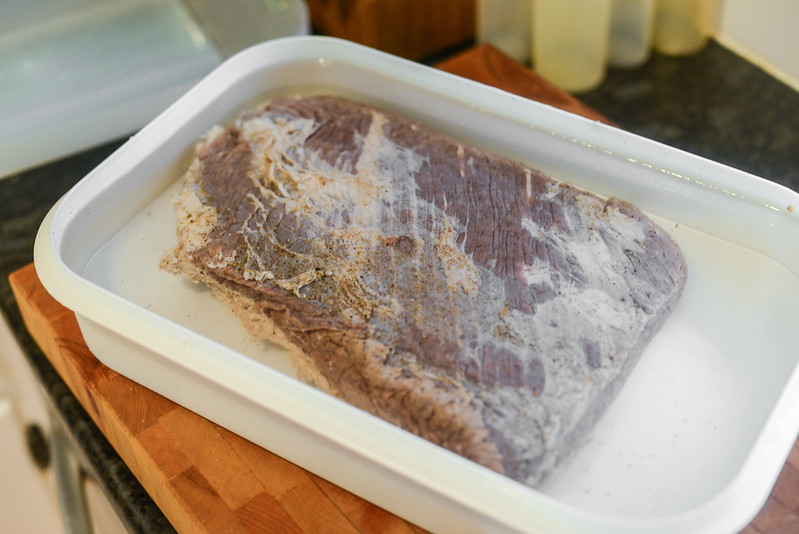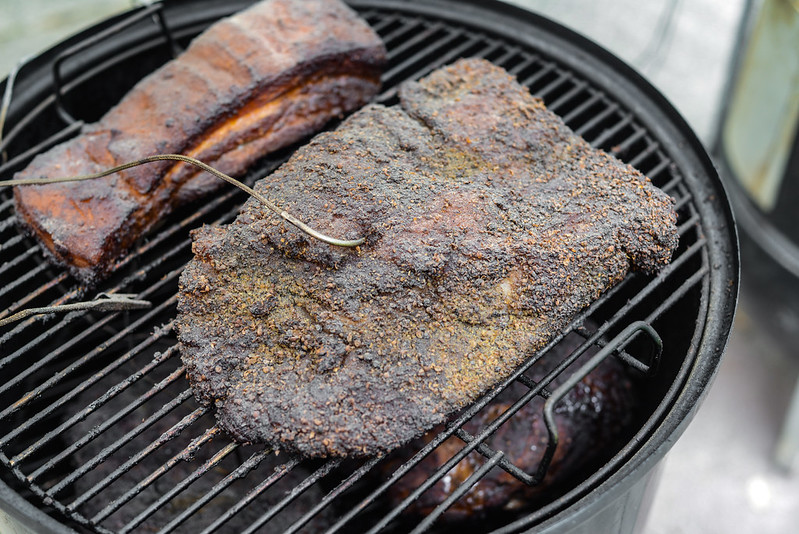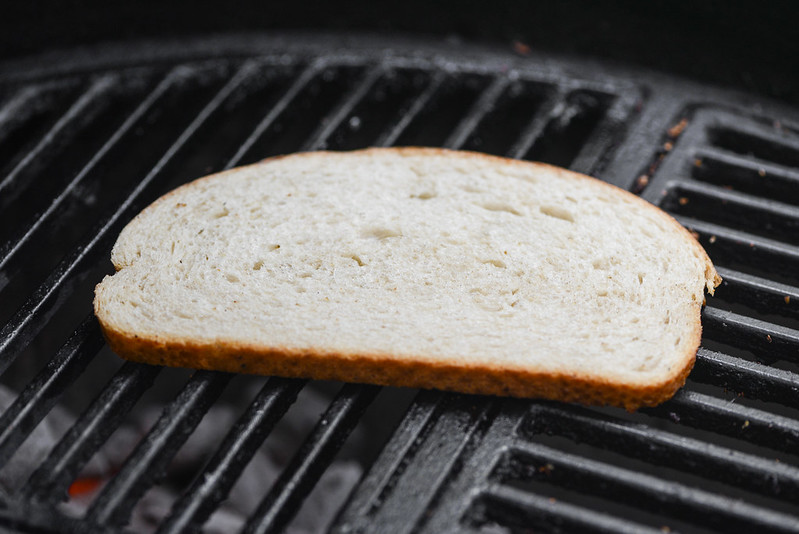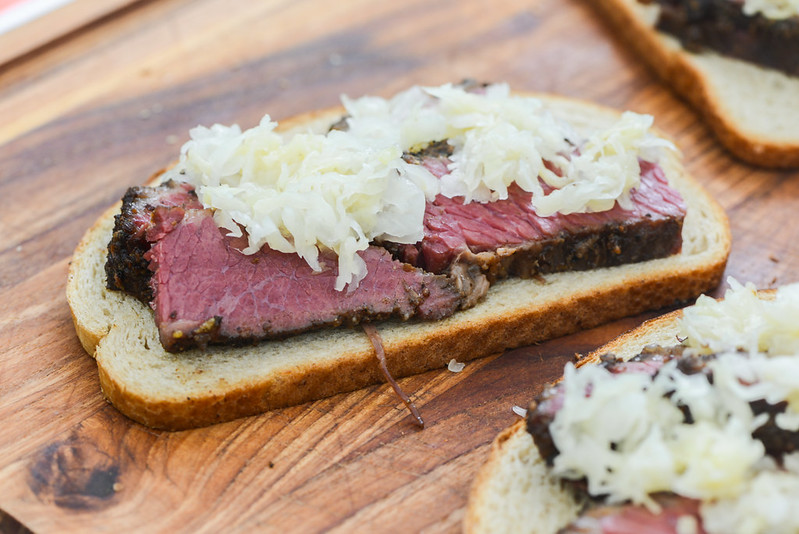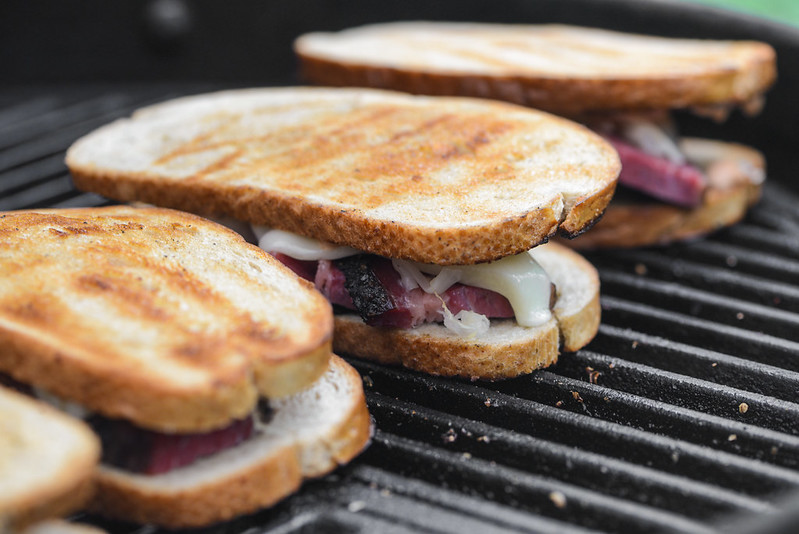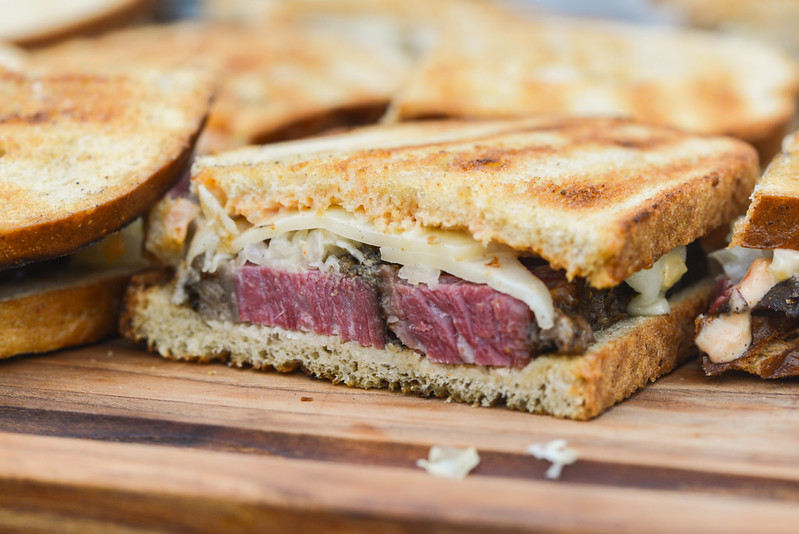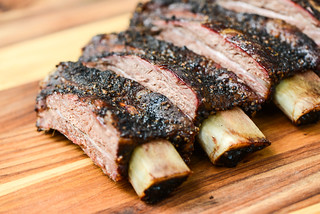Pastrami Reubens
I've done pastrami all sorts of ways at home—traditional, with short ribs, with duck, and even the Montreal equivalent—but for some reason, I've never made it into reubens at a Meatwave. I know, I know, a traditional reuben is made with corned beef, but given the choice between pastrami or corned beef, are you really going to opt for the later, less tasty, cured meat? So when I decided I wanted to make some pastrami for my Memorial Day blowout this year, it was a no brainer to finally assemble it some ruebens to share with my guests and all of you!
I think one reason I didn't make a jump to sandwiches right away is because I was still perfecting my pastrami recipe and process. I feel really good about my pastrami making abilities now, which I start with the flat portion of the brisket. On this day, I actually bought a whole packer brisket, separated the point and the flat, made burnt ends with the point, pastrami with the flat, and then rendered the immense amount of hard fat I trimmed away into beef tallow.
After prepping the meat, keeping the top fat cap in tact, just trimming it down to an even thickness, I then assembled the cure. This was a potent mixture of brown sugar, pepper, coriander, granulated garlic, bay leaves, allspice, and cloves with plenty of salt and the ever important pink curing salt that gives the final product its familiar red color.
I coated the entire flat with a generous portion of the cure before placing it in an extra-large Ziploc bag. I actually like to double bag mine because the meat will release a fair amount of moisture and I want to prevent any leakage that could occur. It was then a four day wait for the cure to work its magic, during which time I flipped the bag over about every twelve hours to help ensure even curing.
While the brisket cured, I had to make a fateful decision—Russian or Thousand Island dressing. For me, it's kind of a no brainer because I think the extra heat and bite imparted by horseradish in Russian dressing is a much better fit for a salty and super seasoned pastrami rueben over sweeter Thousand Island. I kept my Russian dressing pretty simple, yet still delicious, given I already had enough work and ingredients to contend with for the rest of the recipe.
At the end of the four day cure, I removed my now grayish brisket flat from the bag, washed off the exterior spices, and began the process of desalinization. To remove excess salt, I let the brisket soak in water for two hours, changing the water every thirty minutes.
I then patted the meat dry with paper towels and coated it with my pastrami rub. The one thing I thought was really dead one on my first shot at making pastrami was the rub, so I've pretty much always kept this as three parts black pepper, to two parts coriander, to one part granulated garlic (I did add juniper once, but wasn't so impressed that I kept it as a regular ingredient).
Once the liberal coating of rub was applied, the meat went into the smoker, which I already had running at 225°F with some pecan wood thrown on the coals. The first part of the pastrami cook was a lot about forming a thick, dense bark that can hold up to the second, steaming, portion. I've found the exterior is just right when the meat hits around 180-185°F, which can take from five to seven hours.
When my brisket reached this stage, I then wrapped it in foil and poured in a little beer to simulate what places like Katz's do in large steamers. Because foil is non-porous, moisture can't escape, creating an environment of high humidity—so it's essentially steaming. This step could even be done without liquid, but I feel just a little bit of water or beer in the foils helps ensure things stay nice and steamy.
The end goal of the steaming part of the cook is to get the brisket up to a temperature around 196-203°F, at which point the fat becomes so tender that the whole things has a nice jiggle to it. Once done, I poured out the liquid, let the brisket rest in a cooler for an hour or so, and then sliced in to some beautifully red and wonderfully tender meat.
To be honest, on this particular day, I had such a large guest count that I kind of wished I had stopped here because assembling the sandwiches for a giant crowd was quite the time suck. I kept the finally recipe scaled to a manageable eight sandwiches, but this much pastrami can make a whole lot more than that. Despite a hungry crowd and busy schedule, I wasn't going to do these sandwiches any disservice, and began them by buttering and toasting each piece of rye bread.
I then topped the bread with slices of pastrami, sauerkraut, and a piece of Swiss (if you really want to go for the gold, try Gruyere in place of Swiss). Next I slathered healthy portions of Russian dressing on the remaining pieces of bread and finished the sandwich assembly.
Back on the grill the sandwiches went, this time over indirect heat. I wanted to warm them enough to get the cheese all nice and melty, which I saw happening on the edges, but realized wasn't completely melted all the way through only when slicing the reubens in half for serving.
These sandwiches were really the highlight of the day—and that day included both brisket and pork belly burnt ends, Texas style brisket, pulled pork, so that's saying a lot. My years of working on my pastrami recipe and process really paid of with beef that tasted like it had every bit of the sharp and complex seasoning you'd expect along with tender and juicy meat. Starting out with some damn fine pastrami was key, but the flavor combination of tart sauerkraut, creamy Swiss, and sharp and tangy dressing all on some well toasted, crusty rye is something you really just can't go wrong with. I'm sure I'll be making more pastrami in the future, and making it into different end products to have new recipes to share, but deep down in my heart, I'm just always going to want these reubens from now on.
Pastrami Reubens
- Yield 8 servings
- Prep 45 Minutes
- Inactive 4 Days 2 Hours
- Cook 8 Hours
- Total 4 Days 10 Hours 45 Minutes
Ingredients
- For the Cure
- 2/3 cup Kosher salt
- 2 tablespoons packed dark brown sugar
- 2 tablespoons ground black pepper
- 2 tablespoons ground coriander
- 1 tablespoon granulated garlic
- 2 teaspoons pink curing salt
- 1 teaspoon ground bay leaves
- 1/2 teaspoon ground allspice
- 1/2 teaspoon ground cloves
- 1 brisket flat, about 6-8 lbs, fat cap trimmed to 1/8-inch
- For the Russian Dressing
- 1/2 cup mayonnaise
- 3 tablespoons ketchup
- 1 tablespoon finely chopped shallots
- 2 teaspoons prepared white horseradish
- 1 teaspoon Worcestershire sauce
- 1/4 teaspoon sweet paprika
- For the Rub
- 3 tablespoons coarsely ground black pepper
- 2 tablespoons coarsely ground coriander
- 1 tablespoon granulated garlic
- For the Sandwiches
- 16 slices rye bread
- 1/3 cup butter, softened
- 2 cups sauerkraut
- 8 slices Swiss cheese
Procedure
- To make the cure: Mix together salt, dark brown sugar, black pepper, coriander, granulated garlic, pink salt, ground bay leaves, allspice, and cloves in a small bowl. Coat entire brisket with the cure and place in an extra-large resealable plastic bag. Place in the coldest part of the refrigerator and cure for 4 days, flipping bag about every 12 hours.
- To make the Russian dressing: In a small bowl, whisk together mayonnaise, ketchup, shallots, horseradish, Worcestershire sauce, and paprika. Transfer to an airtight container and place in refrigerator until ready to use.
- Remove brisket from bag and wash as much cure off as possible under cold running water. Place brisket in a large container and fill with water and let soak for 2 hours, replacing water every 30 minutes. Remove brisket from water and pat dry with paper towels.
- To make the rub: Mix together black pepper, coriander, and granulated garlic in a small bowl. Coat entire brisket with the rub.
- Fire up smoker or grill to 225 degrees, adding 1-2 fist-size chunks of smoking wood on top of the coals when at temperature. When wood is ignited and producing smoke, place brisket in smoker, fat side up, and smoke until an instant read thermometer registers between 180-185°F when inserted into thickest part of the meat. Wrap brisket in heavy duty aluminum foil, fat side up, leaving an opening on one end of foil. Pour 1/2 cup of water or beer in foil packet through opening, seal, place back on smoker, and cook until an instant read thermometer registers between 196-203°F when inserted into thickest part of the meat. Remove brisket from smoker, pour out liquid from foil packet, and rewrap tightly. Place brisket in cooler or oven and let rest for 1-2 hours. Remove brisket from foil and cut into 1/4-inch slices against the grain.
- To make the sandwiches: Light one chimney full of charcoal. When all charcoal is lit and covered with gray ash, pour out and arrange coals on one side of charcoal grate. Set cooking grate in place, cover grill, and allow to preheat for 5 minutes. Clean and oil grilling grate. Working in batches, butter one side of each slice of bread and place on hot side of grill, buttered side down, and toast until golden brown, about 1 minute. Remove bread from grill and place slices of pastrami on untoasted side of 8 slices of bread. Place about 1/4 cup of sauerkraut on top of pastrami followed by a slice of Swiss cheese. Spread a layer of dressing on untoasted side of remaining 8 pieces of bread and place on top of topped sandwiches. Place sandwiches on cool side of grill, cover, and cook until cheese has melted, about 3 to 5 minutes. Slice each sandwich in half on a diagonal and serve immediately.
